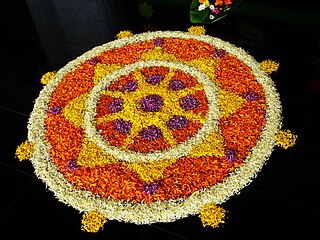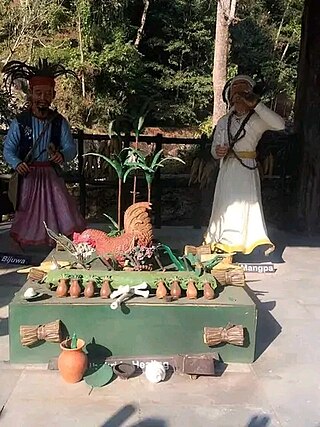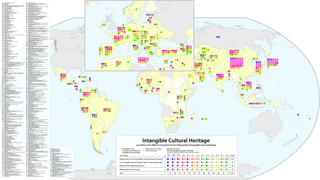 Singer Pathiyur with chengila | |
| Percussion instrument | |
|---|---|
| Other names | Cennala |
| Classification | Idiophone |
| Related instruments | |
| Gong | |
The chengila, or cennala, is an Indian gong which helps the traditional singer or dancer keep time. [1]
 Singer Pathiyur with chengila | |
| Percussion instrument | |
|---|---|
| Other names | Cennala |
| Classification | Idiophone |
| Related instruments | |
| Gong | |
The chengila, or cennala, is an Indian gong which helps the traditional singer or dancer keep time. [1]
The chengila is a percussion instrument that maintains a steady beat and provides musical background.
In Kerala, a state in south-west India, the chengila is used in many different traditional art forms [2] including Chemmanakali, Kathakali, and Krishnanattam. [3]

Bhangra is a type of non-traditional music of Punjab originating from the Punjab region of India and Pakistan. It is a type of upbeat popular music associated with the Punjabi diaspora. The style has its origins in the folk music of Punjab as well as western pop music of the 1970s and 1980s. Prior to this musical fusion, Bhangra existed only as a dance form in the native Punjab Over the years, Bhangra has evolved and gained popularity not only in South Asia but also around the world. It has become a significant part of the cultural identity of the Punjabi diaspora in countries like the United Kingdom, Canada, and the United States. It is a type of upbeat popular music associated with Punjab. The style has its origins in the folk music of Punjab as well as western pop music of the 1970s and 1980s. Prior to this musical fusion, Bhangra existed only as a dance form in the native Punjab. This Punjabi music was unique in that it was not traditional nor did it seek any authenticity. While the traditional folk music of Punjab has a set of melodies that are used by various singers, Bhangra was a form of strict "band culture" in that new melodies were composed for each song. Therefore, the musicians were as important as the singers. Some New Punjabi Singer's are Raka, Vadda Grewal, Prince Poddar, Jass Manak, Karan Randhawa, Guru Randhawa, Diljit Dosanjh

Onam is an annual harvest and cultural festival related to Hinduism that is celebrated mostly by the people of Kerala. A major annual event for Keralites, it is the official festival of the state and includes a spectrum of cultural events.

Tripura is a state in Northeast India. The third-smallest state in the country, it covers 10,491 km2 (4,051 sq mi); and the seventh-least populous state with a population of 3.67 million. It is bordered by Assam and Mizoram to the east and by Bangladesh to the north, south and west. Tripura is divided into 8 districts and 23 sub-divisions, where Agartala is the capital and the largest city in the state. Tripura has 19 different tribal communities with a majority Bengali population. Bengali, English and Kokborok are the state's official languages.
Clothing in India varies with the different ethnicities, geography, climate, and cultural traditions of the people of each region of India. Historically, clothing has evolved from simple garments like kaupina, langota, achkan, lungi, sari, to rituals and dance performances. In urban areas, western clothing is common and uniformly worn by people of all social levels. India also has a great diversity in terms of weaves, fibers, colors, and the material of clothing. Sometimes, color codes are followed in clothing based on the religion and ritual concerned. The clothing in India also encompasses a wide variety of Indian embroidery, prints, handwork, embellishments, and styles of wearing clothes. A wide mix of Indian traditional clothing and western styles can be seen in India.

Chhau, also spelled Chhou, is a semi classical Indian dance with martial and folk traditions. It is found in three styles named after the location where they are performed, i.e. the Purulia Chhau of West Bengal, the Seraikella Chhau of Jharkhand and the Mayurbhanj Chhau of Odisha.

Indian folk music is diverse because of India's enormous cultural diversity. It is sung in various languages and dialects throughout the length and breadth of this vast nation and exported to different parts of the world owing to migration.

Ghoomar or ghumar is a traditional folk dance of Rajasthan. It was the Bhil tribe who performed it to worship Goddess Saraswati which was later embraced by other Rajasthani communities. The dance is chiefly performed by veiled women who wear flowing dresses called ghaghara. The dance typically involves performers pirouetting while moving in and out of a wide circle. The word ghoomna describes the twirling movement of the dancers and is the basis of the word ghoomar.
The Dances of Tripura refer to several forms of folk dance performed in the state of Tripura in northeastern India. These dances are performed by the Tripuri and Mog peoples, during annual regional celebrations, such as sowing and harvesting festivals.

Headbanging is the act of violently shaking one's head in rhythm with music. It is common in rock, punk, heavy metal music and dubstep, where headbanging is often used by musicians on stage. Headbanging is also common in traditional Islamic Sufi music traditions such as Qawwali in the Indian subcontinent and Iran.

The Armenian dance heritage has been considered the oldest and most varied in its respective region. From the fifth to the third millennia B.C., in the higher regions of Armenia, the land of Ararat, there are rock paintings of scenes of country dancing. These dances were most likely accompanied by certain kinds of songs or musical instruments. In the fifth century, Moses of Khoren himself had heard of how the old descendants of Aram make mention of these things in the ballads for the lyre and their songs and dances.

Kanak Rele was an Indian dancer, choreographer, and academic best known as an exponent of Mohiniyattam. She was the founder-director of the Nalanda Dance Research Centre and the founder-principal of the Nalanda Nritya Kala Mahavidyalaya in Mumbai.

The Kaashtha sari is a Koli style of sari draping very similar to the way the Maharashtrian dhoti is worn. The word Kaashtha refers to the sari being tucked at the back. Since this sari is usually worn by using a single nine yard cloth, it is also referred to as Nauvari, which means Nine Yards. Sakachcha sari is another term commonly used to refer to this style of sari. It is referred to as Akanda Vastra, which means it doesn't need any other attire to support it. In fact, this attire holds utmost importance as women across different walks of life have worn it. It is not just worn at religious and cultural events, but women have fought wars in the past and still work in farmlands wearing this.

Kirat Mundum, also known as Kiratism, or Kirati Mundum, is an animistic folk religion of the Kirati ethnic groups of Nepal, Darjeeling and Sikkim, majorly practiced by Yakkha, Limbu, Sunuwar, Rai, Thami, Jirel, Hayu and Surel peoples in the north-eastern Indian subcontinent. The practice is also known as Kirat Veda, Kirat-Ko Veda or Kirat Ko Ved. According to some scholars, such as Tom Woodhatch, it is a blend of shamanism, animism, and Shaivism. It is practiced by about 3.17% of the Nepali population as of 2021.

Maharashtra is the third largest state of India in terms of land area and second largest in terms of population in India. It has a long history of Marathi saints of Varakari religious movement, such as Dnyaneshwar, Namdev, Chokhamela, Eknath and Tukaram which forms the one of bases of the culture of Maharashtra or Marathi culture. Maharashtrian culture had large influence over neighbouring regions under the Maratha Empire.

UNESCO established its Lists of Intangible Cultural Heritage with the aim of ensuring better protection of important intangible cultural heritages worldwide and the awareness of their significance. This list is published by the Intergovernmental Committee for the Safeguarding of Intangible Cultural Heritage, the members of which are elected by State Parties meeting in a General Assembly. Through a compendium of the different oral and intangible treasures of humankind worldwide, the programme aims to draw attention to the importance of safeguarding intangible heritage, which UNESCO has identified as an essential component and as a repository of cultural diversity and of creative expression.
Darshana Jhaveri, the youngest of the four Jhaveri sisters, is a leading Indian exponent of Manipuri dance, an Indian classical dance form. She is a disciple of Guru Bipin Singh, and started performing on stage in 1958 along with her sisters. She is one of the founders of the Manipuri Nartanalaya in 1972, which popularized Manipuri dance in India, and is currently headed by her, with centres at Mumbai, Kolkata and Imphal.

Raja and Radha Reddy are an Indian Kuchipudi dancing couple, gurus and choreographers. They are renowned as exponents of the South Indian dance form of Kuchipudi. They founded and run the Natya Tarangini Institute of Kuchipudi Dance in New Delhi. The duo are credited with having given Kuchipudi a new dimension without compromising on its traditional virtues. For their services to the field of arts, the Government of India has conferred on them the Padma Shri and Padma Bhushan awards.
Bharati Shivaji is an Indian classical dancer of Mohiniyattom, choreographer and author, known for her contributions to the art form by way of performance, research and propagation. She is the founder of Center for Mohiniyattam, a dance academy promoting Mohiniyattom and the co-author of two books, Art of Mohiniyattom and Mohiniyattom. She is a recipient of the Sangeet Natak Akademi Award and Sahitya Kala Parishad Samman. The Government of India awarded her the fourth highest civilian honour of the Padma Shri, in 2004, for her contributions to Indian classical dance.